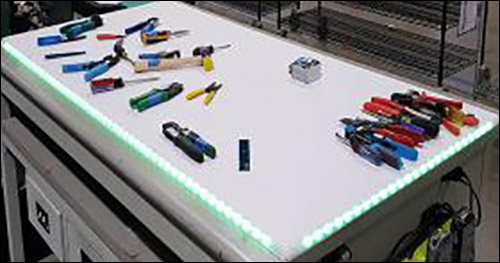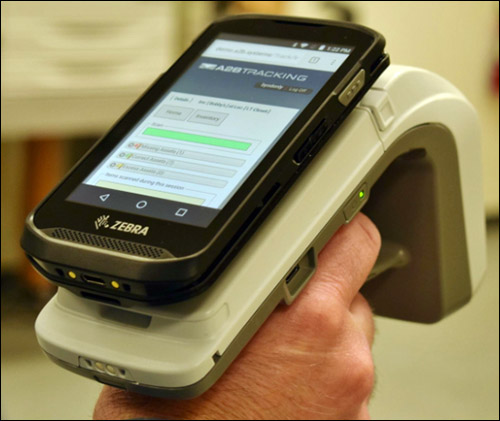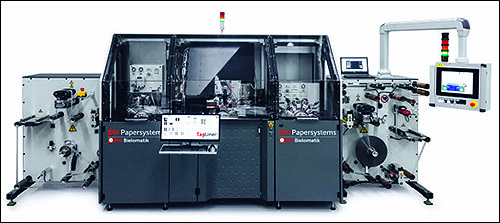The following are news announcements made during the past week by the following organizations:
Venture Research;
A2B Tracking, Zebra Technologies;
BW Bielomatik;
Research Cosmos;
Machinemetrics, and Robert E. Morris Co..
Venture Research Intros RFID-based Tool-Management System
Venture Research, a global supplier of RFID and Internet of Things (IoT) solutions, has announced the availability of Surface Trak, a work surface tool-management system for tracking tool and equipment movement, usage and location. The Surface Trak system monitors tools where work is performed, instead of employees having to move tools to a storage location.
Standard tool-tracking systems tend to utilize RFID- or bar-code-enabled tool cribs that require check-in and checkout procedures. Once a tool is checked out, supervisors can no longer track where the tools are located. At larger manufacturing facilities, the company reports, a typical tool user can spend up to 30 minutes in the morning checking out tools and moving them to a work area. At the end of the day, they then spend another 30 minutes checking their tools back in. This can create a substantial productivity loss, simply for administering tools.

The ability to leave the tools in the work area not only improves efficiency, but provides valuable information to assist in calibration, expiration and tool usage for compliance. Overall profitability is increased, the company reports, due to improved personnel accountability, higher productivity and reduced tool loss.
“Our revolutionary tool tracking system builds on 20 years of experience helping companies of all sizes improve productivity by ensuring the right asset is in the right place when it is needed,” said John Baker, Venture Research’s president, in a prepared statement. “By incorporating the leading edge of RFID and IoT technology, Surface Trak delivers a robust user experience with improved monitoring, notification and visibility into tool tracking usage using a work surface interface.”
The Surface Trak system includes both hardware and software for a fully automated, Web-based solution, is available in either a client-hosted or cloud environment, and is scalable for multi-location deployments. Extensive reporting provides tool utilization for MRO compliance. Venture Research showcased the Surface Trak system at last week’s RFID Journal LIVE! 2018 conference and exhibition.
A2B Tracking Earns Zebra Validation With Rugged Smartphone
A2B Tracking has announced that it has successfully completed Zebra Technologies‘ Software Validation Program for PartnerConnect ISVs. Zebra’s solution lab-certified A2B Tracking’s cloud-based software in a battery of tests, in order to ensure that the software operates for both bar-code and RFID asset tracking with Zebra’s RFD8500 reader, coupled with Zebra’s TC25 rugged smartphone.
Working with Zebra’s engineering teams, A2B Tracking has been awarded validation for numerous Zebra smartphones and touch computers, to confirm that the software meets user application-specific needs, thus reducing risk and deployment times.

A2B Tracking software operates using a browser on the TC25 smartphone, which connects via Bluetooth to the RFD8500 to manage critical asset tracking features, such as locating assets, checking in and out, performing cycle counts and more. A2B Tracking’s proprietary Pro-Locate feature leverages RFID and a TC25 smartphone to search entire facilities to find a specific asset.
“Zebra’s new TC25 rugged smartphone is a perfect fit for field service applications where a traditional Android smartphone isn’t durable enough,” said Tim Collins, Zebra’s chief of operations, in a prepared statement. “A2B Tracking software is easily accessed through a browser on the TC25 and provides instant, powerful RFID tracking for equipment and assets that are used in the field and that are exposed to extreme weather conditions including dust and water. The combination of the Zebra RFD8500 with the TC25 smartphone now enables powerful mobile RFID tracking to provide increased functionality and mobility for any application that requires extra protection from the elements.”
A2B Tracking leverages RFID tracking technology, the company reports, and is compatible with all bar-code asset-tracking and inventory-management systems. This allows an organization to manage all stock and inventory—tracking both serialized and non-serialized items—from in a single, secure, cloud-based system.
BW Bielomatik Unveils Chip-Bonding Concept for RFID Tag Production
BW Papersystems‘ BW Bielomatik brand has launched a solution to produce RFID inlays: the TagLiner. With a fast production speed and high output and bonding strength, the TagLiner is designed to help manufacturers reduce cost and increase efficiency during RFID tag production. The company officially launched the TagLiner at last week’s RFID Journal LIVE! 2018 conference and exhibition.
“The irresistible value proposition of the TagLiner really is its combination of exceptional bonding strength of the RFID chip which can’t be found in any other machine on the market, and its industry-leading output, even at longer product pitches,” said Jürgen Rexer, BW Papersystems’ global technical sales manager for RFID in Stuttgart, Germany, in a prepared statement. “This means, our customers can set new product standards – all while cutting their costs by shortening production times tremendously.”

Additional features include a single-track design for easy operation, short set-up times and a servo-controlled curing device that avoids heat-up changes. End products include RFID inlays made of simpler and lower-cost materials, such as non-transparent substrates like paper, which can help to further reduce cost.
According to the company, production yield is more than 99 percent. When designing the TagLiner, the firm’s focus was on reducing setup times and increasing user-friendliness. For example, with only two curing units installed in the machine, the switching of antenna materials and related setup becomes easier and faster.
While the TagLiner is intended for RFID tag and label manufacturers, its modularity allows for upgrading and capacity expansion in the future. Add-ons anticipated in the future, the company reports, are automated reel change options to shorten down times, as well as the possibility of higher speeds.
Research Cosmos Predicts RFID Tag Market to Reach $13.65 Billion by 2024
Research Cosmos has released a new report, titled “RFID Tags Market By Type (Active RFID and Passive RFID), By Frequency (High-Frequency RFID, Low-Frequency RFID and Ultra-High Frequency RFID), By End User (Healthcare, Retail, Electronics, Logistics and Supply Chain, Transportation and Other (Security and Surveillance, Defense, Agriculture, IT, etc.), Industry trends, Estimation & Forecasts to 2024.” You can browse details of the report here.
The global RFID tag market, according to the report, was valued at $4.6 billion in 2016, and is projected to reach $13.65 billion by 2024, growing at a CAGR of 14.5 percent from 2017 to 2024. Passive RFID generated the highest revenue share at $3.25 billion in 2016, growing at a CAGR of 13.8 percent in the global RFID market. Among major regions, the North American RFID tag market was the highest revenue-generating market, and was valued at $1.88 billion in 2016.
The Asia-Pacific region is forecast to be the largest user of RFID technology in the near future, due to its emergence as the fastest growing market for RFID in the world. In APAC, major countries such as India, Japan, China, Australia and New Zealand have widely accepted RFID tags and are implementing various other applications in the health-care, automobile, logistics, supply-chain, electronics and retail industries.
North America generated the highest revenue in 2016, in terms of the RFID tag market. North America has led the RFID market by generating revenue of $1.86 billion in 2016. However, the Asia-Pacific RFID market is supposed to witness the highest CAGR of 16.4 percent during the forecast period, due to the rapidly growing electronic market of countries like China, India, Singapore and South Korea. Rapidly increasing industrialization and commercialization are invigorating Asian companies to invest in RFID to enhance their supply chain processes.
The cost of RFID tags is declining exponentially due to the increase in its adoption rate and competition among vendors in the industry. Higher inventory accuracy, increased transparency and improved product availability are key propellants of the market. Governments such as federal agencies, state agencies, local government, law enforcement and municipalities are focused on providing high-quality service to the people it serves, while at the same time trying to become more cost effective.
Printing plays a key role in RFID applications, such as labels. As demand grows for more RFID tags and labels, printing could play a greater role. The key potential applications for RFID smart labels were seen as being primarily in retail, media management (books, CDs, videos, documents, etc.), fashion/apparel, airline-baggage handling and the pharmaceutical sector. Key market applications achieving the best levels of growth can be found in the fields of asset tracking, cargo tracking and security, supply-chain management (pallet, case and item) and especially identification (travel) documents.
High-frequency RFID tags are suitable for tracking products as they move through the manufacturing process in light industrial applications. The HF band ranges from 3 MHz to 30 MHz. HF RFID is primarily used for ticketing, library books, payment, data transfer, waste management, tool management and patient flow tracking. The market is expected to have a CAGR of 12.8 percent during the forecast period. However, the highest CAGR is to be witnessed by the UHF RFID market.
On the contrary, the report says, there are some misconceptions about the RFID tags that can hinder their exponential growth to some extent. Unwanted data can be accumulated in a large number whenever the tags pass through multiple readers in the absence of proper filtering mechanism. Unlike bar codes, there is no universal standardization for RFID tags, which makes it confined to local markets. Security-related concerns, like the misuse or eavesdropping of data with the use of unauthorized readers, can also pose a great threat to the market growth.
The leading players in the global RFID market have adopted major strategies, according to the research, such as collaborations, product launches, and agreement and acquisition. Key market players include Zebra Technologies, Omni-ID, Impinj, Smartrac, Alien Technology, Confidex, Honeywell International, Invengo Information Technology, Wavetrent and NXP Semiconductors Netherlands.
Machinemetrics, Robert E. Morris Co. Partner for Smart Manufacturing
MachineMetrics has announced that it will exhibit its Industrial Internet of Things (IIoT) platform at next month’s Smart Manufacturing Experience, to be held in Boston. The company will exhibit its IIoT technology in the booths of The Robert E. Morris Co. and Tsugami/Rem Sales, as well as in its own dedicated booth, with the goal of recreating a real-world, smart manufacturing environment.
Bill Bither, MachineMetrics’ CEO, will join Lou Olson, The Robert E. Morris Co.’s president, for the event’s keynote presentation, titled “Dynamics of Change: Disruptive Technologies and CNC Machinery.” The two will discuss the benefits of applying advanced manufacturing technologies, and will explain how early adopters of emerging technologies are improving productivity, part quality and profitability.
“A great deal of hesitancy still exists for manufacturers to embrace the technology that addresses the new challenges presented by digital transformation,” Bither said in a prepared statement. “With installing cloud-based monitoring systems being the first and perhaps most important step toward data-driven manufacturing, we designed MachineMetrics to help companies overcome these challenges and create a roadmap forward so they can take this initial and crucial step. We are proud to be developing the future of manufacturing alongside them.”
Despite producing the greatest amount of data of any industry in the United States, the company reports, manufacturing is the furthest behind any other global industry in digital transformation efforts. Roughly 50 percent of U.S. manufacturers admit to not having a systematic roadmap or toolbox for the easy rollout of digital manufacturing solutions, and more than 15 percent of all U.S. manufacturers identify a lack of knowledge about suitable providers as their biggest obstacle. Because no standard roadmap for digital manufacturing exists, many are often uncertain about where to start and what foundational capabilities are required to succeed.
With self-install IIoT connectivity, MachineMetrics’ predictive-analytics and machine-learning platform allows manufacturers to harness, structure and take action on data, driving manufacturing efficiency by more than 20 percent, on average, for customers. Now integrated into factories across North America and Europe, MachineMetrics is growing fast with more than 50 customers, including Fastenal, Snap-On Tools, Gardner Denver, TurboCam and Shiloh Automotive, as well as partnerships with McKinsey and Co., SECO Tools and Robert E. Morris Co.
MachineMetrics was recently awarded “Smart Manufacturing Solution of the Year” by the committee at IoT Breakthrough, the winner of the Massachusetts TechHub Caucus’ 2018 NEXTGEN Technology Award, one of 20 tech-ecosystem partners of McKinsey for its Digital Manufacturing Growth Initiative and a Top 10 Manufacturing Intelligence Solution Provider for 2017, as named by Manufacturing Technology Insights.

